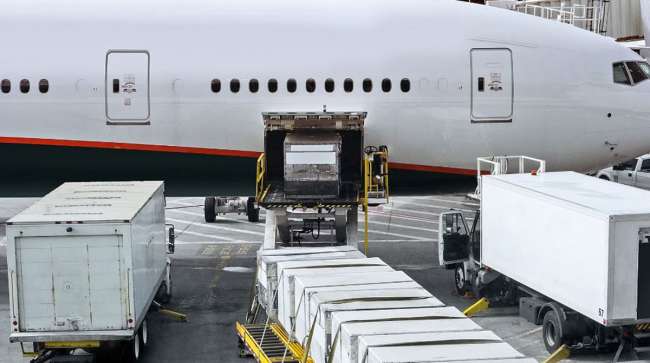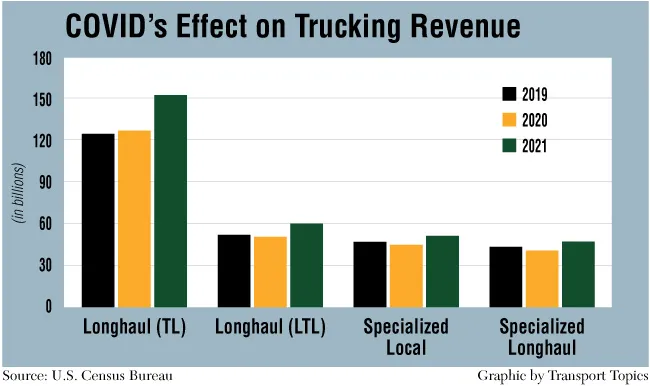Staff Reporter
Census Bureau: Two Trucking Sectors Prospered During Pandemic

[Stay on top of transportation news: Get TTNews in your inbox.]
Freight forwarding and longhaul trucking for truckload experienced the highest business booms for revenue from 2019 to 2021 during the pandemic, a new U.S. Census Bureau analysis on freight transportation reveals.
“Lockdowns and travel restrictions had a significant impact on the transportation industries, but not all segments,” a Sept. 27 notice by the Census Bureau stated. “Unlike freight transportation industries, estimated revenues for industries supporting passenger transportation saw no increases from 2019 to 2020.”
Its revenue-trend assessment of passenger and freight transportation was based on results from its 2021 Service Annual Survey. The questionnaire, mandated by law, requires companies to provide data (to be kept confidential) that the Census Bureau uses to measure U.S. economic performance and provide business sector metrics for government policymakers, corporate leaders and the public.
In analyzing revenue for U.S. freight transportation industries during the COVID-19 pandemic that began with a March 11, 2020, World Health Organization declaration, the Census Bureau evaluated data involving freight moved by air, water and land along with a freight transportation arrangement category.
“Despite obstacles like labor shortages, disruptions in port operations and changes to working conditions among others, some freight transportation industries thrived with the help of increased demand and higher prices,” the Census Bureau noted.

The two sectors that flourished from 2019 through 2021 during the darkest days of the pandemic through shutdowns, supply chain disruptions and vaccination requirements were freight forwarding (called freight transportation arrangement) and longhaul trucking for truckload .Experiencing the biggest revenue surge was the freight transportation arrangement industry. This sector consists of businesses that primarily arrange freight transportation between shippers and carriers by offering a combination of multimodal services, such as with freight forwarders, shipping agents (marine and other) and customs brokers.
Freight transportation arrangement revenue reached $130.1 billion in 2019 and soared by 53.4% to $199.8 billion in 2022 after initially climbing 11% in 2021, which was the hardest year for many U.S. companies.
Also performing well was longhaul trucking for truckload, which grew 22% to $152.4 billion in 2021 from 2019’s $124.5 billion. By contrast, there was only a slight increase from 2019 to 2010, 1.8% to $126.8 billion.
What does it take to become the best technician in the country? Hear from two experts who supervised the exams at TMCSuperTech. Tune in above or by going to RoadSigns.ttnews.com.
After experiencing a slight dip (down 2.7%) in 2020 compared to $51.9 billion a year earlier, longhaul trucking for less-than-truckload rebounded and soared 15.7% to $60 billion in 2019.
Modest gains were made in both specialized (nonused goods) local freight trucking to $51.2 billion in 2021 (up 9.4%) compared to $46.8 billion in 2019 and in specialized longhaul freight trucking, registering $47 billion (8.8% higher) in 2021 versus $43.1 billion in 2019.
Annual revenue in both categories recovered after falling in 2020: down 6.2% for specialized longhaul freight and down 4.6% for specialized local freight trucking.
“Revenues of employer firms in the scheduled freight air transportation industry were $7.6 billion in 2021, up 14.9% from 2020 and 17.2% from 2019,” the Census Bureau stated.
Scheduled freight air transportation is a category for businesses moving cargo by air (without transporting passengers) on regularly scheduled routes. These companies operate flights, even if partially loaded, and include providing contract services for scheduled air transportation of mail. Except for air couriers, this category includes scheduled air cargo, airmail, cargo, freight, helicopter freight and airfreight carriers as well as scheduled airfreight transportation.
Want more news? Listen to today's daily briefing above or go here for more info
“Deep sea freight transportation revenues were $6.9 billion for employer firms in 2021, an 8.8% increase from 2020 and a 9.3% increase from [the] 2019 estimate,” the bureau noted.
Two categories of water freight transportation failed to fully recover during the pandemic from 2019 revenue comparisons. Coastal and Great Lakes freight transportation dropped by more than $1 billion to $7 billion in 2020 and by 5.8% in 2021 to $7.6 billion against $8 billion in 2019.
Inland water freight transportation slid 11.4% to $5.8 billion in 2020 and increased a bit in 2021 to $6 billion but was still down 8.9% compared with 2019’s $6.6 billion.





